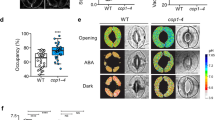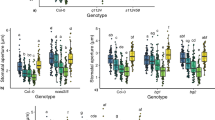Abstract
The continuing rise in atmospheric CO2 causes stomatal pores in leaves to close and thus globally affects CO2 influx into plants, water use efficiency and leaf heat stress1,2,3,4. However, the CO2-binding proteins that control this response remain unknown. Moreover, which cell type responds to CO2, mesophyll or guard cells, and whether photosynthesis mediates this response are matters of debate5,6,7,8. We demonstrate that Arabidopsis thaliana double-mutant plants in the β-carbonic anhydrases βCA1 and βCA4 show impaired CO2-regulation of stomatal movements and increased stomatal density, but retain functional abscisic-acid and blue-light responses. βCA-mediated CO2-triggered stomatal movements are not, in first-order, linked to whole leaf photosynthesis and can function in guard cells. Furthermore, guard cell βca-overexpressing plants exhibit instantaneous enhanced water use efficiency. Guard cell expression of mammalian αCAII complements the reduced sensitivity of ca1 ca4 plants, showing that carbonic anhydrase-mediated catalysis is an important mechanism for βCA-mediated CO2-induced stomatal closure and patch clamp analyses indicate that CO2/HCO3− transfers the signal to anion channel regulation. These findings, together with ht1-2 (ref. 9) epistasis analysis demonstrate that carbonic anhydrases function early in the CO2 signalling pathway, which controls gas-exchange between plants and the atmosphere.
This is a preview of subscription content, access via your institution
Access options
Subscribe to this journal
Receive 12 print issues and online access
$209.00 per year
only $17.42 per issue
Buy this article
- Purchase on Springer Link
- Instant access to full article PDF
Prices may be subject to local taxes which are calculated during checkout





Similar content being viewed by others
Change history
16 May 2011
In the version of this letter initially published online and in print, the competing financial interests were incomplete.
References
Sellers, P. J. et al. Modeling the exchanges of energy, water, and carbon between continents and the atmosphere. Science 275, 502–509 (1997).
Medlyn, B. E. et al. Stomatal conductance of forest species after long-term exposure to elevated CO2 concentration: a synthesis. New Phytol. 149, 247–264 (2001).
LaDeau, S. L. & Clark, J. S. Rising CO2 levels and the fecundity of forest trees. Science 292, 95–98 (2001).
Battisti, D. S. & Naylor, R. L. Historical warnings of future food insecurity with unprecedented seasonal heat. Science 323, 240–244 (2009).
von Caemmerer, S. et al. Stomatal conductance does not correlate with photosynthetic capacity in transgenic tobacco with reduced amounts of Rubisco. J. Exp. Bot. 55, 1157–1166 (2004).
Messinger, S. M., Buckley, T. N. & Mott, K. A. Evidence for involvement of photosynthetic processes in the stomatal response to CO2 . Plant Physiol. 140, 771–778 (2006).
Roelfsema, M. R. et al. Guard cells in albino leaf patches do not respond to photosynthetically active radiation, but are sensitive to blue light, CO2 and abscisic acid. Plant Cell Environ. 29, 1595–1605 (2006).
Mott, K. A., Sibbernsen, E. D. & Shope, J. C. The role of the mesophyll in stomatal responses to light and CO2 . Plant Cell Environ. 31, 1299–1306 (2008).
Hashimoto, M. et al. Arabidopsis HT1 kinase controls stomatal movements in response to CO2 . Nature Cell Biol. 8, 391–397 (2006).
Webb, A. A. & Hetherington, A. M. Convergence of the abscisic acid, CO2, and extracellular calcium signal transduction pathways in stomatal guard cells. Plant Physiol. 114, 1557–1560 (1997).
Leymarie, J., Vavasseur, A. & Lasceve, G. CO2 sensing in stomata of abi1–1 and abi2–1 mutants of Arabidopsis thaliana. Plant Physiol. Biochem. 36, 539–543 (1998).
Young, J. J. et al. CO2 signaling in guard cells: calcium sensitivity response modulation, a Ca2+-independent phase, and CO2 insensitivity of the gca2 mutant. Proc. Natl Acad. Sci. USA 103, 7506–7511 (2006).
Vahisalu, T. et al. SLAC1 is required for plant guard cell S-type anion channel function in stomatal signalling. Nature 452, 487–491 (2008).
Negi, J. et al. CO2 regulator SLAC1 and its homologues are essential for anion homeostasis in plant cells. Nature 452, 483–486 (2008).
Lee, M. et al. The ABC transporter AtABCB14 is a malate importer and modulates stomatal response to CO2 . Nature Cell Biol. 10, 1217–1223 (2008).
Marten, H. et al. Silencing of NtMPK4 impairs CO2-induced stomatal closure, activation of anion channels and cytosolic Ca2+ signals in Nicotiana tabacum guard cells. Plant J. 55, 698–708 (2008).
Gehlen, J. et al. Effects of altered phosphoenolpyruvate carboxylase activities on transgenic C3 plant Solanum tuberosum. Plant Mol. Biol. 32, 831–848 (1996).
Cousins, A. B. et al. The role of phosphoenolpyruvate carboxylase during C4 photosynthetic isotope exchange and stomatal conductance. Plant Physiol. 145, 1006–1017 (2007).
Kinoshita, T. et al. PHOT1 and PHOT2 mediate blue light regulation of stomatal opening. Nature 414, 656–660 (2001).
Mori, I. C. et al. CDPKs CPK6 and CPK3 function in ABA regulation of guard cell S-type anion- and Ca2+-permeable channels and stomatal closure. PLoS Biol. 4, 1749–1762 (2006).
Leonhardt, N. et al. Microarray expression analyses of Arabidopsis guard cells and isolation of a recessive abscisic acid hypersensitive protein phosphatase 2C mutant. Plant Cell 16, 596–615 (2004).
Yang, Y., Costa, A., Leonhardt, N., Siegel, R. S. & Schroeder, J. I. Isolation of a strong Arabidopsis guard cell promoter and its potential role as a research tool. Pl. Methods 4, 1–15 (2008).
Zhao, Z., Zhang, W., Stanley, B. A. & Assmann, S. M. Functional proteomics of Arabidopsis thaliana guard cells uncovers new stomatal signaling pathways. Plant Cell 20, 3210–3226 (2008).
Fabre, N., Reiter, I. M., Becuwe-Linka, N., Genty, B. & Rumeau, D. Characterization and expression analysis of genes encoding α and β carbonic anhydrases in Arabidopsis. Plant Cell Environ. 30, 617–629 (2007).
Kawamura, Y. & Uemura, M. Mass spectrometric approach for identifying putative plasma membrane proteins of Arabidopsis leaves associated with cold acclimation. Plant J. 36, 141–154 (2003).
Froehlich, J. E. et al. Proteomic study of the Arabidopsis thaliana chloroplastic envelope membrane utilizing alternatives to traditional two-dimensional electrophoresis. J. Proteome Res. 2, 413–425 (2003).
Uehlein, N. et al. Function of Nicotiana tabacum aquaporins as chloroplast gas pores challenges the concept of membrane CO2 permeability. Plant Cell 20, 648–657 (2008).
Bergmann, D. C. & Sack, F. D. Stomatal development. Annu. Rev. Plant Biol. 58, 163–181 (2007).
Shpak, E. D., McAbee, J. M., Pillitteri, L. J. & Torii, K. U. Stomatal patterning and differentiation by synergistic interactions of receptor kinases. Science 309, 290–293 (2005).
Lu, J. et al. Effect of human carbonic anhydrase II on the activity of the human electrogenic Na+/HCO3- cotransporter NBCe1-A in Xenopus oocytes. J. Biol. Chem. 281, 19241–19250 (2006).
Lake, J. A., Quick, W. P., Beerling, D. J. & Woodward, F. I. Plant development. Signals from mature to new leaves. Nature 411, 154 (2001).
Jacob, E. J. Water: under pressure. Nature 452, 269 (2008).
Price, N. D., Reed, J. L. & Palsson, B. O. Genome-scale models of microbial cells: evaluating the consequences of constraints. Nature Rev. Microbiol. 2, 886–897 (2004).
Brearley, J., Venis, M. A. & Blatt, M. R. The effect of elevated CO2 concentrations on K+ and anion channels of Vicia faba L. guard cells. Planta 203, 145–154 (1997).
Witte, C. P., Noel, L. D., Gielbert, J., Parker, J. E. & Romeis, T. Rapid one-step protein purification from plant material using the eight-amino acid StrepII epitope. Plant Mol. Biol. 55, 135–147 (2004).
Boisson-Dernier, A., Frietsch, S., Kim, T. H., Dizon, M. B. & Schroeder, J. I. The peroxin loss-of-function mutation abstinence by mutual consent disrupts male-female gametophyte recognition. Curr. Biol. 18, 63–68 (2008).
Czechowski, T., Stitt, M., Altmann, T., Udvardi, M. K. & Scheible, W. R. Genome-wide identification and testing of superior reference genes for transcript normalization in Arabidopsis. Plant Physiol. 139, 5–17 (2005).
Udvardi, M. K., Czechowski, T. & Scheible, W. R. Eleven golden rules of quantitative RT-PCR. Plant Cell 20, 1736–1737 (2008).
Wilbur, K. M. & Anderson, N. G. Electrometric and colorimetric determination of carbonic anhydrase. J. Biol. Chem. 11 (1948).
Genty, B., Briantais, J. M. & Baker, N. R. The relationship between the quantum yield of photosynthetic electron-transport and quenching of chlorophyll fluorescence. Biochem. Biophys. Acta 990, 87–92 (1989).
Allen, G. J., Murata, Y., Chu, S. P., Nafisi, M. & Schroeder, J. I. Hypersensitivity of abscisic acid-induced cytosolic calcium increases in the Arabidopsis farnesyltransferase mutant era1–2. Plant Cell 14, 1649–1662 (2002).
Natelson, S. & Nobel, D. More on blood bicarbonate measurement. Clinical Chem. 24, 1082–1083 (1978).
Pigott, J. D. Coupled ion-selective electrode measurement of aqueous carbonate and bicarbonate ion activities. Anal. Chem. 61, 638–640 (1989).
Feys, B. J. et al. Arabidopsis senescence-associated gene101 stabilizes and signals within an enhanced disease susceptibility1 complex in plant innate immunity. Plant Cell 17, 2601–2613 (2005).
Robatzek, S., Chinchilla, D. & Boller, T. Light-induced endocytosis of the pattern recognition receptor FLS2 in Arabidopsis. Genes Dev. 20, 537–543 (2006).
Kubo, M. et al. Transcription switches for protoxylem and metaxylem vessel formation. Genes Dev. 19, 1855–1860 (2005).
Walter, M. et al. Visualization of protein interactions in living plant cells using bimolecular fluorescence complementation. Plant J. 40, 428–438 (2004).
Acknowledgements
We thank M. Maktabi, J. Young and C. Engineer for preliminary analyses of βca mutants, R. Xu for assistance, S. Zeeman for suggestions and K. Iba (Kyushu University, Japan) for providing ht1-2 seeds. This research was supported by NSF (MCB0918220), NIH (GM060396) and in part by DOE (DE-FG02-03ER15449) grants (to J.I.S.) and by fellowships from the Swedish Research Council Formas (to M.I.-N.), the Deutsche Forschungsgemeinschaft (to M.B.), EMBO (to J.M.K.) and in part from the King Abdullah University of Science and Technology (KAUST; No. KUS-F1-021-31 to H.H.).
Author information
Authors and Affiliations
Contributions
J.I.S. conceived the project and proposed the experimental design. H.H., A. B.-D. and M.I.-N. performed most of the experiments and contributed equally to the work. M.B. performed CA activity analyses. S.X. performed patch clamp experiments. A.R. contributed to stomatal movement and stomatal index measurements. J.G. performed norflurazon experiments. J.M.K. analysed CO2/HCO3−-binding protein-encoding gene expression patterns and isolated the initial CA, PEPC and Rubisco T-DNA insertion lines. J.I.S., H.H., A.B.-D. and M.I.-N. wrote the paper.
Corresponding author
Ethics declarations
Competing interests
The University of California, San Diego, has submitted a patent form on behalf of J.I.S., M.I-N., J.M.K., H.H. and A.B.D. on aspects of the findings.
Supplementary information
Supplementary Information
Supplementary Information (PDF 3329 kb)
Rights and permissions
About this article
Cite this article
Hu, H., Boisson-Dernier, A., Israelsson-Nordström, M. et al. Carbonic anhydrases are upstream regulators of CO2-controlled stomatal movements in guard cells. Nat Cell Biol 12, 87–93 (2010). https://doi.org/10.1038/ncb2009
Received:
Accepted:
Published:
Issue Date:
DOI: https://doi.org/10.1038/ncb2009
This article is cited by
-
Genome-wide identification, evolution, and expression analysis of carbonic anhydrases genes in soybean (Glycine max)
Functional & Integrative Genomics (2023)
-
The intrinsically disordered region from PP2C phosphatases functions as a conserved CO2 sensor
Nature Cell Biology (2022)
-
On the role of guard cells in sensing environmental signals and memorising stress periods
Theoretical and Experimental Plant Physiology (2022)
-
Role of C4 photosynthetic enzyme isoforms in C3 plants and their potential applications in improving agronomic traits in crops
Photosynthesis Research (2022)
-
Guard cell endomembrane Ca2+-ATPases underpin a ‘carbon memory’ of photosynthetic assimilation that impacts on water-use efficiency
Nature Plants (2021)



